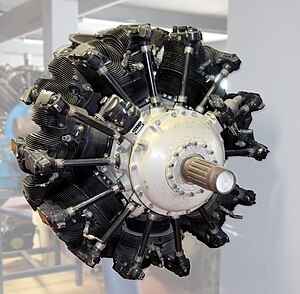
The Hispano-Suiza 12Y was an aircraft engine produced by Hispano-Suiza for the French Air Force before the Second World War. The 12Y became the primary French 1,000 hp (750 kW) class engine and was used in a number of famous aircraft, including the Morane-Saulnier M.S.406 and Dewoitine D.520.

The 12Z, designated Type 89 by the company, was the final evolution of the series of Hispano-Suiza V-12 aircraft engines. The Z model had just entered production when France fell to the Germans during World War II. A small number were produced during the war but the German occupation government would not allow full-scale production to start. After the war small numbers were built to equip new designs, but the rapid introduction of the jet engine ended further development.
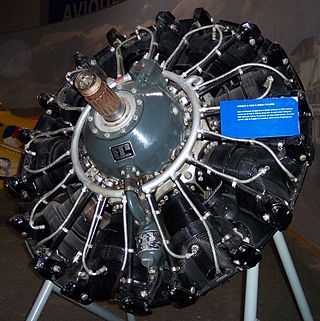
The Wright R-1820 Cyclone 9 is an American radial engine developed by Curtiss-Wright, widely used on aircraft in the 1930s through 1950s. It was produced under license in France as the Hispano-Suiza 9V or Hispano-Wright 9V, and in the Soviet Union as the Shvetsov M-25.

The Hispano-Suiza 8 was a water-cooled V8 SOHC aero engine introduced by Hispano-Suiza in 1914, and was the most commonly used liquid-cooled engine in the aircraft of the Entente Powers during the First World War. The original Hispano-Suiza 8A was rated at 140 hp (100 kW) and the later, larger displacement Hispano-Suiza 8F reached 330 hp (250 kW).

The Klimov M-105 was a V12 liquid-cooled piston aircraft engine used by Soviet aircraft during World War II.

The Klimov VK-107 was a V-12 liquid-cooled piston aircraft engine used by Soviet aircraft during World War II.
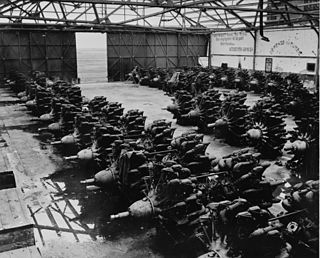
The Gnome-Rhône 14K Mistral Major was a 14-cylinder, two-row, air-cooled radial engine. It was Gnome-Rhône's major aircraft engine prior to World War II, and matured into a highly sought-after design that would see licensed production throughout Europe and Japan. Thousands of Mistral Major engines were produced, used on a wide variety of aircraft.

The Wright R-975 Whirlwind was a series of nine-cylinder air-cooled radial aircraft engines built by the Wright Aeronautical division of Curtiss-Wright. These engines had a displacement of about 975 cu in (15.98 L) and power ratings of 300–450 hp (220–340 kW). They were the largest members of the Wright Whirlwind engine family to be produced commercially, and they were also the most numerous.

The Gnome-Rhône 14M was a small 14-cylinder two-row air-cooled radial engine that was used on several French and German aircraft of World War II. While having the same appearance, number of pistons (14) and two-row layout typical of Gnome-Rhône radial engines, the 14M was built to a smaller frame intended to power a lighter class of aircraft. It was designed with lower displacement and power, smaller in size and with less weight compared to the larger, heavier Gnome-Rhône 14N and its well-known predecessor.

The Klimov M-103 is a V12 liquid-cooled piston aircraft engine used by Soviet aircraft during World War II.

The Hispano-Suiza 12X was an aircraft piston engine designed in France by Hispano-Suiza during the early 1930s. A 12-cylinder Vee, liquid-cooled design, the 12X was used on several aircraft types, some of them being used in limited numbers during World War II. Due to the 12X's limited power output, its derivative the more powerful Hispano-Suiza 12Y had a longer career.
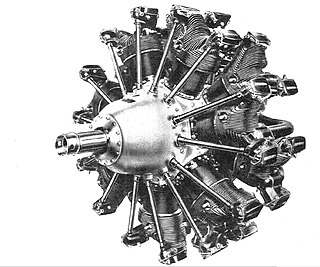
The Hispano-Suiza 14AA, also known as Type 79, was a fourteen-cylinder aircraft radial engine used in France during the late 1930s. As Hispano-Suiza lacked recent experience in developing radial engines, it was derived from the licensed Wright R-2600 engine. Due to reliability problems, the engine was largely supplanted by the similar Gnome-Rhône 14N.

The Wright R-540 Whirlwind was a series of five-cylinder air-cooled radial aircraft engines built by the Wright Aeronautical division of Curtiss-Wright. These engines had a displacement of 540 in³ (8.85 L) and power ratings of around 165-175 hp (123-130 kW). They were the smallest members of the Wright Whirlwind engine family.

The Armstrong Siddeley Cougar was an aero engine developed by Armstrong Siddeley in 1945. The design was a departure from earlier Armstrong Siddeley engines in many ways, it was the company's only nine-cylinder radial design. Although the engine was tested it did not find an aircraft application and was not produced.

The Avia Rk.17 was a 9-cylinder radial aircraft engine, developed from the 7-cylinder Avia Rk.12, with a rated output of 270 kW (360 hp). The Rk.17 was one of Avia's own designs and was built in Czechoslovakia in the 1930s.

The SNECMA 14R was a 14-cylinder two-row air-cooled radial engine developed in France just prior to the start of World War II from the Gnome-Rhône 14N. The 14N radial engine was itself an improved version of the popular pre-war Gnome-Rhône 14K Mistral Major series; designed and manufactured by Gnome et Rhône, a major French aircraft engine manufacturer whose origins pre-date the First World War.
The Hispano-Suiza 12N was one of two new V-12 engine designs first run in 1928 and was manufactured by Hispano-Suiza's French subsidiary for the Armee d'l'Air. It produced about 485 kW (650 hp), was the first to use gas nitride hardening and introduced wet cylinder liners into Hispano-Suiza's aircraft engine range. It powered the first non-stop flight from Europe to the United States.

The Hispano-Suiza 12M was one of two new V-12 engine designs first run in 1927–1928. It produced about 375 kW (500 hp), was the first to use gas nitride hardening and introduced wet cylinder liners into Hispano-Suiza's aircraft engine range.
Hispano-Suiza piston aero-engines were predominantly piston engines produced by Hispano-Suiza in France, Spain, and under licence in the United Kingdom, the United States and Russia from the First World War through to the 1950s. Development of these engines started with the very successful V-8 engines which introduced many new features which ensured the success of the Hispano-Suiza line.
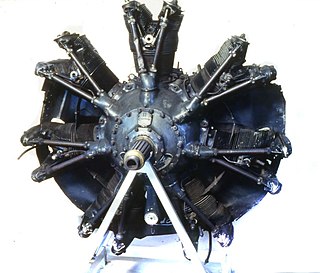
The Piaggio Stella P.VII was the first P series aircraft engine produced by Rinaldo Piaggio S.p.A. Based on its experience license-producing the Gnome-Rhône 7K, Piaggio sold the engine to be used on a wide range of Italian aircraft before and during World War II, including the record-breaking Caproni Ca.133.
